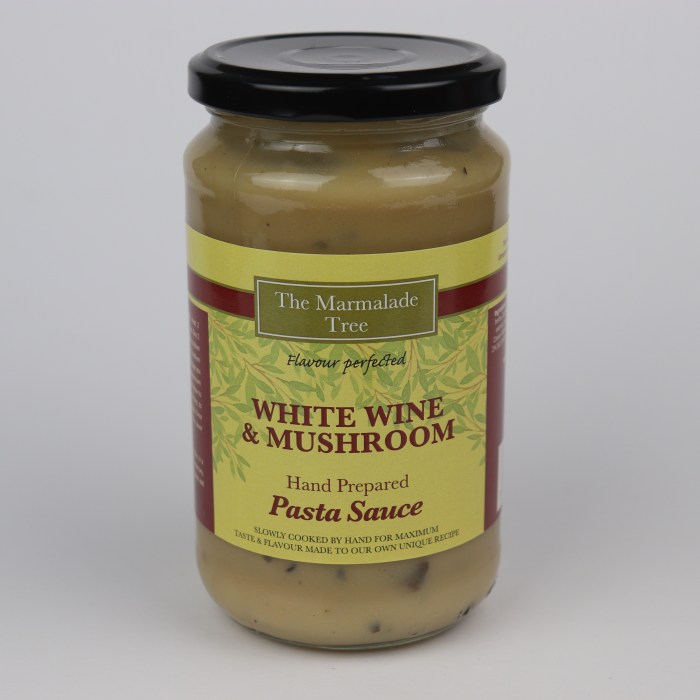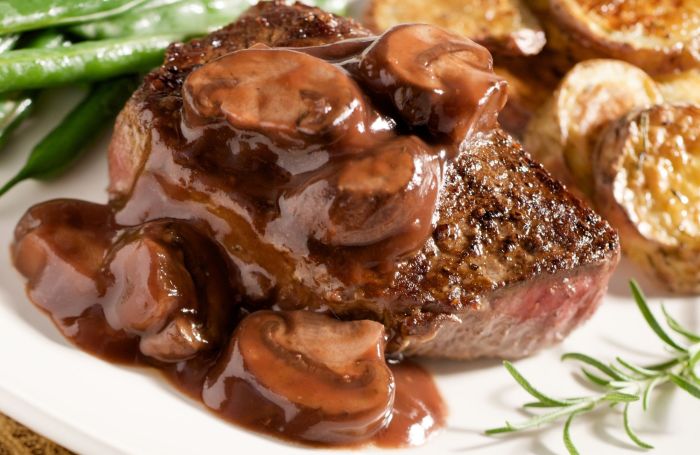Recipe for Mushroom Wine Sauce
Crafting the Perfect Mushroom Wine Sauce
Recipe for mushroom wine sauce – A rich and flavorful mushroom wine sauce elevates any dish, from simple pasta to a gourmet steak. This guide provides a comprehensive approach to creating this culinary masterpiece, covering mushroom selection, sauce preparation, flavor enhancements, and serving suggestions.
Mushroom Selection and Preparation
Choosing the right mushrooms is crucial for achieving the desired taste and texture in your wine sauce. Different varieties offer unique flavor profiles and require specific preparation techniques.
Ideal mushrooms for a wine sauce include cremini (brown button), shiitake, portobello, and oyster mushrooms. Cremini offer a mild, earthy flavor, while shiitake mushrooms boast a more intense, umami-rich taste. Portobellos, with their meaty texture, add depth and substance, and oyster mushrooms contribute a delicate, slightly sweet flavor.
Cleaning mushrooms is essential to remove any dirt or debris. Gently wipe them with a damp cloth or use a soft brush. Avoid washing them under running water, as they tend to absorb moisture, which can dilute the sauce. For tougher mushrooms like portobellos, you can carefully scrape off any dirt with a knife.
The ideal chop size for mushrooms in a wine sauce depends on your preference. For a more rustic sauce, chop the mushrooms into larger pieces (about ½ inch). For a smoother sauce, opt for smaller pieces (¼ inch). Consistent chopping ensures even cooking and prevents some pieces from becoming overcooked while others remain undercooked.
| Mushroom Type | Flavor Profile | Texture | Cooking Time (approx.) |
|---|---|---|---|
| Cremini | Mild, earthy | Firm, tender | 5-7 minutes |
| Shiitake | Umami-rich, savory | Firm, slightly chewy | 7-10 minutes |
| Portobello | Earthy, meaty | Meaty, substantial | 10-12 minutes |
| Oyster | Delicate, slightly sweet | Tender, delicate | 3-5 minutes |
Wine Sauce Base Creation
The foundation of a delicious mushroom wine sauce lies in a well-crafted wine reduction. This process involves simmering wine until it reduces in volume, intensifying its flavor.
For a red wine sauce, start by sautéing aromatics like shallots or garlic in butter or oil. Add your chosen red wine (Cabernet Sauvignon or Pinot Noir work well) and let it simmer until reduced by about half. Deglazing the pan by scraping up the browned bits from the bottom adds depth of flavor.
A white wine sauce follows a similar process, using a dry white wine like Chardonnay or Sauvignon Blanc. White wine sauces tend to be lighter and brighter in flavor compared to their red counterparts. The choice of wine significantly impacts the final flavor profile of the sauce; a bolder wine will yield a more robust sauce.
- Sauté aromatics (shallots, garlic) in butter or oil.
- Add wine and simmer until reduced by half.
- Deglaze the pan to incorporate browned bits.
- Add stock or cream for richness (optional).
- Simmer until desired consistency is reached.
Incorporating Mushrooms into the Sauce

Source: co.uk
Adding mushrooms at the right time is crucial for achieving the perfect texture and preventing a watery sauce. The cooking method also affects the final result.
It’s best to add the mushrooms towards the end of the sauce’s cooking time. Sautéing the mushrooms before adding them to the sauce helps to release their moisture and develop their flavor. Braising, on the other hand, results in a more tender mushroom, but it might take longer.
To prevent a watery sauce, ensure the mushrooms are thoroughly cooked before incorporating them into the sauce. This removes excess moisture, allowing the sauce to thicken properly. Careful heat control is key; avoid high heat, which can cause the mushrooms to release too much water too quickly.
Sautéing mushrooms before adding them to the sauce ensures they release their moisture, preventing a watery final product. Proper heat control during the cooking process is key to achieving a balanced and flavorful sauce.
Flavor Enhancements and Variations, Recipe for mushroom wine sauce

Source: myfoodom.com
Herbs and spices can elevate a mushroom wine sauce to new heights. Fresh thyme, rosemary, or sage complement the earthy notes of mushrooms beautifully. A touch of black pepper or a pinch of nutmeg adds warmth and complexity.
Cream, shallots, garlic, and even a splash of balsamic vinegar can be incorporated to create variations of the sauce. Adjusting the amount of cooking liquid affects the thickness. Simmering longer creates a thicker, richer sauce.
| Sauce Variation | Ingredients | Description |
|---|---|---|
| Creamy Mushroom Sauce | Heavy cream, thyme, parsley | Rich and decadent, perfect for pasta dishes. |
| Garlic-Shallot Mushroom Sauce | Shallots, garlic, white wine | Savory and aromatic, ideal for steak or chicken. |
| Balsamic Mushroom Sauce | Balsamic vinegar, fresh thyme, black pepper | Tangy and complex, pairs well with roasted vegetables. |
Serving Suggestions and Visual Presentation
Mushroom wine sauce is a versatile accompaniment to a wide range of dishes. It pairs exceptionally well with pasta dishes, grilled steaks, roasted chicken, and even creamy polenta. The sauce’s visual appeal enhances the dining experience.
A beautifully presented sauce adds to the overall dining experience. A glossy, rich color, a smooth, velvety texture, and a consistent consistency are hallmarks of a perfectly prepared sauce. Garnishing with fresh herbs like parsley or thyme, or a sprinkle of Parmesan cheese, adds a touch of elegance.
To garnish, consider a sprinkle of freshly chopped parsley or thyme, a drizzle of high-quality olive oil, or a grating of Parmesan cheese. The visual appeal of the sauce, including its rich color and smooth consistency, should complement the overall presentation of the dish.
Popular Questions: Recipe For Mushroom Wine Sauce
Can I use canned mushrooms?
While fresh mushrooms are preferred for optimal flavor and texture, canned mushrooms can be used in a pinch. Just ensure they are well-drained before adding them to the sauce.
How long can I store leftover mushroom wine sauce?
A rich mushroom wine sauce elevates any dish, its earthy depth a perfect complement to various proteins. For a contrasting yet equally delicious condiment, consider checking out this fantastic recipe for cracker barrel tartar sauce ; its tangy brightness offers a delightful counterpoint. Returning to our mushroom sauce, remember to reduce the wine slowly to develop its full flavor profile before adding the mushrooms.
Store leftover sauce in an airtight container in the refrigerator for up to 3 days.
What happens if I add too much wine?
If you add too much wine, simply simmer the sauce longer to reduce the liquid and concentrate the flavors. You can also add a cornstarch slurry to thicken the sauce.
Can I freeze mushroom wine sauce?
Yes, you can freeze mushroom wine sauce for up to 2 months. Allow it to thaw completely in the refrigerator before reheating.




















